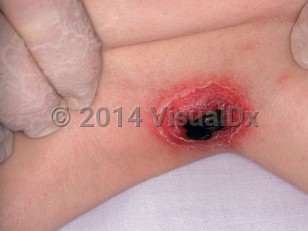- Rapid assessment of airway, breathing, and circulation (ABCs) is imperative in any neonate with suspected sepsis. The neonate's airway should be secured and ventilatory assistance provided as needed. Supplemental oxygen may be required.
- Intravenous (IV) access with an umbilical vein catheter (UVC) line or peripheral intravenous (PIV) line should be quickly established if not already present.
- Crystalloid fluid boluses (10 cc/kg) may be needed to support circulation.
- A blood culture of at least 1 mL should be obtained, in addition to a CBC with differential / platelets, C-reactive protein (CRP), and procalcitonin.
- In the setting of later-onset sepsis (an infant older than 72 hours), a urinalysis and urine culture should be obtained.
- If pre-existing catheters are in place, separate blood cultures should also be obtained from these lines and labeled appropriately.
- If central nervous system (CNS) involvement is suspected or if a blood culture is positive, a lumbar puncture with cerebrospinal fluid (CSF) analysis, culture, polymerase chain reaction (PCR) studies, and Gram stain should be done if the infant is stable enough to tolerate the procedure.
- If vesicular skin lesions are present, viral PCR studies should be done for herpes simplex virus (HSV).
- Empiric antibiotics should begin as soon as possible. Specific antibiotic selection will vary based on intensive care unit (ICU) / regional resistance patterns. A typical initial regimen would be IV ampicillin plus IV aminoglycoside for early-onset sepsis (younger than 72 hours) with IV vancomycin and an aminoglycoside for later-onset sepsis.
- If CNS involvement is suspected, a third-generation cephalosporin such as cefotaxime is used in place of an aminoglycoside.
- Ceftriaxone should NOT be used as it may increase risk of kernicterus.
- Acyclovir should be added if HSV is suspected.
This summary discusses bacterial sepsis in neonates. Bacterial sepsis in adults and children is addressed separately.
Bacterial sepsis is a major problem in the neonatal intensive care unit: 10% of admitted neonates are treated with antibiotics for presumed sepsis, but a bacterial cause is defined in less than 10% (2/1000 live births) of these treated infants. The highest rates of bacterial sepsis are in preterm infants, particularly those of very low birth weight (less than 1500 g). Also at higher risk are those with decreased respiratory function at birth and those with maternal risk factors such as prolonged (greater than 24 hours) rupture of membranes, bleeding complications, precipitous delivery, toxemia, and maternal infection. Risk is higher in males, Black newborns, and newborns with congenital malformations, particularly of the genitourinary tract.
In developing countries, reported rates of neonatal sepsis are 3-20 times higher than in industrialized countries, presumably due to poor intra- and postpartum infection control practices. Neonatal deaths in developing countries total 1.6 million a year, most from sepsis.
Neonatal sepsis is classified as either early (younger than 7 days old) or late (older than 7 days old) onset. Some define the cutoff at 5 days between early and late onset. Early onset is due to acquisition of organisms from the mother; 85% of cases occur in the first 24 hours after birth and 5% in the next 24 hours. Organisms most often associated are group B Streptococcus, Escherichia coli, Haemophilus influenzae, and Listeria monocytogenes. Other possible agents are Neisseria meningitides and Neisseria gonorrhoeae, Klebsiella, Enterococcus spp, and other streptococci.
Late-onset sepsis is acquired from the environment. Staphylococci are the most common cause (30%-50%), particularly coagulase-negative strains, and are associated with indwelling catheters and lines. The neonate's skin, umbilicus, respiratory and gastrointestinal tracts, and conjunctivae may become colonized from the environment. Other common organisms are E coli, Klebsiella, Pseudomonas, Enterobacter, Serratia, Acinetobacter, Streptococcus, anaerobes, and Candida. Nosocomial infections in the ICU may be due to multidrug-resistant organisms. Some viral organisms may present with signs indistinguishable from bacterial sepsis (eg, enterovirus, adenovirus, respiratory syncytial virus, and HSV).
Complications from sepsis include pneumonia (particularly in early-onset sepsis) and meningitis (more often seen with late-onset sepsis). Other systemic signs of sepsis may include diminished spontaneous activity, decreased sucking vigor, apnea, bradycardia, shock, temperature instability, jaundice, diarrhea, vomiting, and abdominal distention. Site-specific signs of infection include edema, erythema and warmth, coma, seizures, opisthotonos, and a bulging fontanelle.
The overall mortality of early-onset sepsis is 15%-50%, and late-onset sepsis mortality is 10%-20%. The fatality rate is 2-4 times higher in low-birth-weight infants.
Residual neurologic damage occurs in 15%-30% of neonates with septic meningitis.



